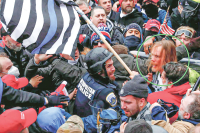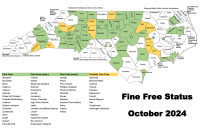Recommended diversions
The Green Book
Looking for more ways to help save energy costs and be more environmentally responsible? Check out this helpful book from Elizabeth Rogers and Thomas M. Kostigen. It’s chock full of easy-to-follow tips for helping save the planet from the effects of climate change. Some of the suggestions include recycling and cutting down on the use of petroleum-based products like excessive packaging. That means using canvas bags instead of the store’s plastic bags and buying blocks of cheese instead of the individually wrapped cheese slices.
By turning off power strips when they’re not being used, Americans could save $1 billion in wasted electricity. Turn off lights and other electronic devices when they’re not in use. Lower your heat or air conditioner when you’re not at work. Reuse a water bottle instead of consuming lots of individual water bottles or cups that often end up in landfills. Turn off the tap water when you’re brushing your teeth. You can conserve five gallons of water a day. Buy appliances with the Energy Star label that are more energy efficient and can save households $600 a year on energy costs. Skip gift wrapping when you can. Use newspapers or reuse gift bags and ribbons. If each family in the U.S. family reused 2 feet of holiday ribbon each year, 38,000 miles of ribbon could be saved from the trash dumps — enough to wrap around the planet. Also included in The Green Book are tons of Web sites for learning more about reducing our carbon footprint.
Michelangelo’s Seizure
Renoir. Monet. Goya. Rembrandt. Imagine their paintings and their lives on display as the thousand-word pictures we see in museums. But instead of the visual images framed in temperature-controlled rooms, what if we could capture their genius in words alone, each page full of marvelous metaphors and dizzy-delicious phrases every bit as rich as the paintings themselves. Poet Steve Gehrke takes us inside the worlds of these artists in his latest award-winning book of poems, Michelangelo’s Seizure. Part art history and part lyrical passion, these poems ponder Monet’s blindness, Magritte’s suicidal mother, and Michelangelo’s cramped quarters on the scaffolding of the Sistine Chapel. This style of poetry is known as “ekphrastic” [ek-FRAS-tik], which in Greek means “calling out.” It’s meant to describe, imitate, critique or dramatize a work of non-literary art, usually visual art. After reading Gehrke’s poems about Gericault’s maddening scene in “The Raft of the Medusa” or J.M.W. Turner’s hue-hazy study, “The Burning of Parliament, 1834,” I wonder what these painters might have thought of such imaginative verse tributes.
Place names
While researching the history of Haywood County recently, I’ve come across some interesting stories behind local place names. Haywood County, for example, was named after John Haywood (1787-1827), a long-running state treasurer and the first mayor of Raleigh. Haywood was also a founding trustee for the University of North Carolina at Chapel Hill.
Meanwhile, Canton was renamed several times from Forks of Pigeon to Buford before its present name, which came from Canton, Ohio, the source of steel used to make one of the town’s bridges. Waynesville, on the other hand, was named after Gen. “Mad” Anthony Wayne, who was nicknamed for his brash attacks against the British during the Revolutionary War. Wayne’s namesake is found not only in Haywood County and North Carolina’s Wayne County but also in dozens of other Wayne counties, towns, roads and schools throughout the U.S. including Ft. Wayne, Indiana. This same Anthony Wayne inspired subsequent names such as cowboy actor John Wayne, Batman’s alter ego Bruce Wayne and NASCAR driver Tony Stewart, whose full name is Anthony Wayne Stewart.
— By Michael Beadle





